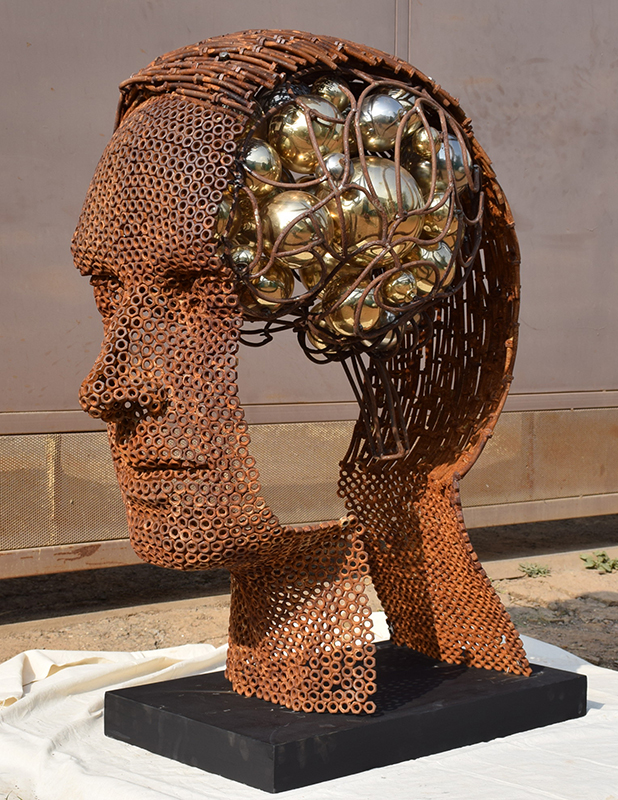‘The sculptor must paint with his chisel; half his touches are not to realize, but to put power into the form. They are touches of light and shadow, and raise a ridge, or sink a hollow, not to represent an actual ridge or hollow, but to get a line of light, or a spot of darkness.’ -John Ruskin
Creativity in Prabhakar Singh’s work, in a few words, is arresting of sensations. Prabhakar has carved his niche with his individualistic approach in the field of Visual art. He has a way of direct representation and that’s the reason the spectator can easily guess the meaning or theme of his sculptures. He doesn’t make sculptures like a craftsman but tries to catch everything through the mind’s eyes. He can project his inner chaos and desires and even everyday themes through his sculptures by giving them a new life, which are directly engaged to his emotions. Though the expression is direct, the thoughts behind are very deep.
There are many artists like Jennis Kounellis who has used iron beams, knives and torn coats; Indonesian artist Ono Gaf who picks up metal scraps and turns them into art pieces; Iranian artist and designer Hasan Novrozi; Korean artist Yeong-Deok-Seo who creates imposing figurative sculptures using tightly knit configurations of welded bicycle chains and industrial steel chains; Spain-based sculptor Manuel Mart Moreno and Alexey Doubrovsky from Minsk, Belarus who creates figurative sculptures made out of iron nuts. Similarly, Prabhakar has experimented with old and worn out iron, which makes him nostalgic about the things which one gets attached to and finds difficult to part with. His artworks have been innovatively created out of kitchen utensils, garden tools, nuts and bolts and even metallic pipes, and other everyday items.
Prabhakar’s sculptures are a concoction of many elements. To an artist’s eye, his work is a path paved out through various experiences whereas to a spectator it is just a complete seeing. His series on Heads/faces is full of experimentations of textures and medium. Here too, he is trying to break the solidity of sculptural technique and maintaining the hollow structure. Exterior and interior form their own equations, where every object stuck in the sculpture has a story to tell. His sculpture Poet, three feet high, a male head, is constructed from iron nuts and bolts and retains the natural shade of the metal, devoid of any polishing. Variations in the sizes of the shining brass balls, adorning the inner structure of the head, confined in poet’s brain by spiral rods, is the depiction of numerous thoughts going on in poet’s mind. Sliced head breaks the monotony of the structure from where one can peep into the soul of the poet. When one looks at the sculpture from the front it appears to be a complete head, whereas the glance from the side exposes another hollow dimension of the artwork, which just shows the outline of the design. Housewife, three feet high, is a female head, made up of iron and stainless steel and has been a part of National Art Exhibition by Lalit Kala Akademi, New Delhi, 2018. This narrative sculpture is also based on the same style like ‘Poet’ with hollow dimensions. The brass balls have been replaced by the stainless steel kitchen utensils though.
Social worker, ten feet high with base, is made by joining iron pipes. The character of a social worker, who lives his life by thinking of people and by resolving their problems, has been portrayed by multiple male and female heads made of fibre glass reinforcement plastic installed in the structural pattern of the big head. More beauty has been personified in antique gold of a female head, eleven feet high, made by welding iron flowers for face and flattened iron leaves for head. Face of Buddha is made up of small squares and what attracts one is the idea of each square enfolding small idols of gods and goddesses, which reaches up to the number of three to four hundred. The squares and the spiral hair of Buddha are being highlighted by the turquoise contrast of patina, the shade rubbed into the grooves of the idols and hair. Another entrancing sculpture is of a female head made of copper, by joining together antique coins of uneven sizes.
Prabhakar has been an assistant Professor at Minerva College of Architecture, Talegaon, Pune since 2014 and a Visiting Faculty at Suryadatta Institute of design, Pune since 2015. The influence of architectural patterns is visible in one of the head sculptures where he has used flat strips of iron to create impression of brick and the rod embellished with flowers and leaves popping out of the sliced head. The place where he achieved his education from, Banaras has also showed its impact in a Sadhu’s sculpture made out of flattened circles with beard and bun. He has tried his hand on ceramic heads too, but the miniature figures and objects of brass can be seen added to the glazed material to make it more captivating and enticing. Prabhakar’s creative process encompasses clay designing, mould release, hammering of brass, copper or iron objects as per the shape of the mould and then welding and setting the pieces as per the idea. The creation with different patterns and mediums, by exploiting the texture for apt expression, makes even the simple theme like heads so intriguing and fascinating.
One of his series is fabricated from brass rod and brass ‘ghungroo’ (musical anklet).The exterior view of the musical anklet resembles flower. Apple is created from flowers, which in its centre cocoons spherical Earth, as if protecting it from the fetters of lack of brotherhood, greed and mistrust prevailing among people. Prabhakar’s sculptures have two surfaces. The outer structure is transparent, which makes the inner part exposed to the eyes. He has represented the hidden interior, without any mystery, yet creating a mystery. This inside story has always enthralled him in his artistic depictions whether in form of a sculpture or play of words through his poems. The artworks are embellished with words, symbols and figures. He has to his list myriad explorations through numerous mediums like body casting sculptures, plywood and fibre. He has made many miniature sculptures in materials like resin, stone dust, ceramics and even paper mache like ladies playing musical instruments, writing letters, a couple on swings, a standing figure, or in front of easel painting on canvas, bow and arrow, drums, figures with harvesting tools and masks of welded scrap iron. He has even created yoga monuments in concrete; and bull, rooster, peacock, turtle, crocodile, ostrich, snake, reindeer etc. in welded iron. Prabhakar’s art is a stylistic elaboration, where there is a positive exploitation of even the rotten or waste material and shackles of all old restraints are gone.


